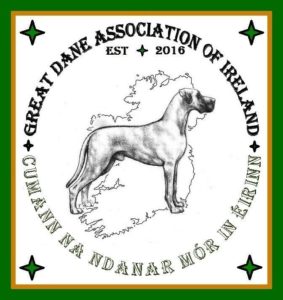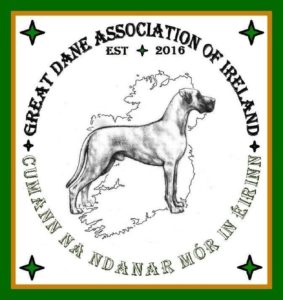The purpose of this information, adapted from the Great Dane Club of America, Inc. is to educate the public about the responsibility involved in owning a Great Dane and the many issues they should consider before purchasing a Dane puppy or adult. Our breeder-members would like to know that when someone decides to own a Great Dane, that this dog, whether a puppy or an older dog, will have a permanent, loving home. We want to do all we can to make sure that prospective new owners understand the characteristics of the breed and are willing to make a commitment to provide a suitable environment and proper training which will make the Great Dane a healthy and well-behaved member of the family. All too often people make hasty decisions and are ill-prepared to deal with the size and sometimes rambunctious and destructive behavior of an adolescent Great Dane. Unwanted Great Danes are then turned over to rescue organizations or animal shelters, or worse yet, are abandoned to wander the streets. The fate of most of the animals, through no fault of their own, is death. Reputable breeders take the responsibility to educate new owners so that when they send puppies to their new homes, the experience will be good for both the puppies and the new owners. However, the new owners must share in this responsibility.
As a prospective new owner, we urge you to take time to learn about the Great Dane through books, magazines, and affiliated Great Dane clubs throughout the country. These clubs are made up of members familiar with the breed, and they are excellent sources of information. The GDAI website, is a great place to start.
The Great Dane was developed primarily in Germany and England out of mastiff-type and Greyhound stock. The principal purpose of the breed in early years was to hunt wild boar. At that time, ears were cropped to prevent the boar’s long, sharp tusks from shredding the Dane’s ear during the hunt. However, the Great Dane as we know it today was developed in Europe during the 1800′s and declared the national breed of Germany in 1876. As a boarhound, the Dane of yesterday was very different both in structure and temperament from the Dane of today. When no longer used for hunting, the breed changed to one of a companion and estate dog.

The Great Dane body should be as long as it is tall, with substantial bone, a long tail, a relatively long neck, a rectangular head, and a definite stop. Most books on the Great Dane have excellent illustrations which depict Danes of various colors and sexes. Adult male Great Danes generally measure about 33″ to 36″ at the shoulder and weigh about 140 to 175 pounds. Females are smaller, about 31″ to 33″ and about 110 to 140 pounds. Full height is usually reached at 12 to 15 months of age, but a Great Dane is not fully mature until about three years old. Ears can be cropped or uncropped. If uncropped, the ears should lie against the sides of the head and have a slight rise at the ear where it meets the base of the skull. Cropped ears should be carried erect and should complement the rectangular appearance of the head. Danes come in six recognized colors:
FAWN: (tan with black mask)
BRINDLE: (tan with black stripes)
BLACK: (solid black)
BLUE: (steel blue)
HARLEQUIN: (white base coat with evenly distributed torn black patches)
MANTLE: (black head and body, with white on the muzzle, collar, chest, feet/legs, and a white-tipped tail).
Danes with colors or markings besides these six may be registered with the AKC, but they cannot be shown and generally speaking should not be bred. Regardless of color, all can make fine family pets.
Great Danes make wonderful family pets for a household which wants a large, affectionate short-haired breed who will offer a measure of protection. They are a very people-oriented breed and need to be a part of the family. Great Danes do not do well in kennel situations or where they are exclusively outdoor dogs. They need and crave human companionship. Their coat is not sufficient to keep them warm in the winter, so they must be kept indoors in colder climates.
Great Danes are loving, easy to housebreak, simple to groom, and of average intelligence. Proper early training and socialization are very important. Puppy kindergarten classes are recommended, beginning at about three to six months of age. These classes should be followed with a basic obedience class. Although Great Danes who have been raised with children are usually very gentle, they are much larger than a small child. Because accidental injuries can occur, even with very well mannered Great Danes; small children should never be left unattended with your puppy or dog. If there are children in the household, they must be taught the correct way to interact with a puppy and parents need to monitor correct behavior on the part of the child and the puppy.
The household considering a Dane should have a secure enclosure and preferably a large, fenced yard. Chaining, staking out, tying or allowing your Dane to roam free are dangerous and unacceptable practices.
Most Danes are not jumpers, so a six-foot fence is sufficient. Many growing puppies are highly destructive to landscaping, so if a beautifully landscaped yard is a priority for you, perhaps you should reconsider getting a Great Dane!
Inside the house, a crate, properly used, will help assist in housebreaking a young puppy and prevent major destruction from a chewing adolescent. To prevent problems, young Danes should not be allowed free run of the house until they have proven themselves to be trustworthy. A Dane on a chewing spree can easily ruin beds, carpeting and furniture.
Danes should never be encouraged to be overly protective or aggressive. Their large size is sufficient to scare off most intruders. Their natural tendency is to protect if needed. It is the responsibility of the Dane owner to socialize his Dane properly so the dog can learn good judgment.
Owners of Great Danes should recognize that some people are very frightened of large dogs. Therefore, Dane owners need to always act in a responsible manner, keeping their Danes leashed and under control when in public places and confined within fenced yards when at home.
Compared to other breeds, Great Danes can be expensive to maintain. Providing proper food, veterinary care, supplies, training classes, and a fenced yard can quickly add up. Everything is “more” with a Dane because of its size.
The most negative aspect of the breed is a short life span, typically about 7 to 10 years. Great Danes are predisposed to certain health problems such as gastric torsion (bloat), certain types of cancer, and heart problems. Puppies and young adults can develop certain growing or bone problems which are sometimes associated with an improper diet, often a diet too high in protein, calcium or supplements. Occasionally, Great Danes can be aggressive with livestock or may not get along with other animals in the household. Older adult males can be prone to prostate infections and adult bitches to false pregnancies and uterine infections. Spaying or neutering pets is a good idea for the health of the dog and is required by most ethical breeders.

